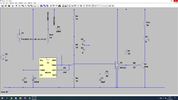ThomsCircuit
Well-Known Member
Id like to adapt this circuit to support more than 1 LED. I want to use this with a strip of LEDs i have. The strip is 15 feet. has 300 2835 leds. Draws about 2 amps @ 12v
The circuit should fade the leds from 0 to max current when turned on and max to 0 when turned off. the fade duration should be 2 seconds. From what I understand the fade duration is controlled by the capacitor when turned on and then R1 and R2 work with the cap to slow the drain when turned off. What I dont get is the author states that if R2 was omitted the fade off would take much longer. Less resistance (1K) = slower drain. Seems that less resistance would mean a faster drain. I know that question will get me in a lot of trouble (LOL) because my ability to grasps formulas is not as good as i wish they were but my curiosity will have to deal with it.
The author also explains that by changing R12 & C1 will affect the fade duration but what about adjusting for the load on the circuit? Here the circuit is only controlling a fed leds. What would i need to alter for my needs? 150 - 300 leds?
Thank you in advance.
T.B.

The circuit should fade the leds from 0 to max current when turned on and max to 0 when turned off. the fade duration should be 2 seconds. From what I understand the fade duration is controlled by the capacitor when turned on and then R1 and R2 work with the cap to slow the drain when turned off. What I dont get is the author states that if R2 was omitted the fade off would take much longer. Less resistance (1K) = slower drain. Seems that less resistance would mean a faster drain. I know that question will get me in a lot of trouble (LOL) because my ability to grasps formulas is not as good as i wish they were but my curiosity will have to deal with it.
The author also explains that by changing R12 & C1 will affect the fade duration but what about adjusting for the load on the circuit? Here the circuit is only controlling a fed leds. What would i need to alter for my needs? 150 - 300 leds?
Thank you in advance.
T.B.



